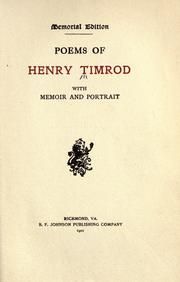The earliest edition of Timrod's poems was a small volume by Ticknor & Fields, of Boston, in 1860, just before the Civil War. This contained only the poems of the first eight or nine years previous, and was warmly welcomed North and South. The "New York Tribune" then greeted this small first volume in these words: "These poems are worthy of a wide audience, and they form a welcome offering to the common literature of our country."
In this first volume was evinced the culture, the lively fancy, the delicate and vigorous imagination, and the finished artistic power of his mind, even then rejoicing in the fullness and freshness of its creations and in the unwearied flow of its natural music. But it fell then on the great world of letters almost unheeded, shut out by the war cloud that soon broke upon the land, enveloping all in darkness.
The edition of his complete poems was not issued until the South was recovering from the ravage of war, and was entitled "The Poems of Henry Timrod, edited with a sketch of the Poet's life by Paul H. Hayne. E. J. Hale & Son, publishers, New York, 1873." And immediately, in 1874, there followed a second edition of this volume, which contained the noble series of war poems and other lyrics written since the edition of 1860. In 1884 an illustrated edition of "Katie" was published by Hale & Son, New York. All of these editions were long ago exhausted by an admiring public.
The present edition contains the poems of all the former editions, and also some earlier poems not heretofore published.
From 1848 to 1853 he submitted a number of poems to The Southern Literary Messenger, under the pen name Aglaus, where he attracted some attention for his abilities. Encouraged, he left the field of law for writing and tutoring.
In 1856 he accepted a post as a teacher at the plantation of Col. William Henry Cannon in the area that would later become Florence, South Carolina. The single room school building (still preserved in Timrod Park in Florence) was built to provide for the education of the plantation children. Among his students was the young lady who would later become his bride and the object of a number of his poems - the fair Saxon Katie Godwin.
Henry Timrod's schoolpreserved in Timrod Park, Florence, South Carolina
Enlarge
Henry Timrod's school
preserved in Timrod Park, Florence, South Carolina
While teaching and tutoring he continued also to publish his poems in literary magazines. In 1860, he published a small book, which, although a commercial failure, increased his fame. The best known poem from the book was A Vision of Poesy.
With the outbreak of war, Henry returned to Charleston, soon publishing his best known poems, which drew many young men to enlist in the service of the Confederacy. His best known poems of the time are Ethnogenesis, A Cry to Arms, Carolina, and Katie. He was a frequent contributor of poems to Russell's Magazine and to The Southern Literary Messenger.
Timrod soon followed into the military, but illness prevented much service, and he was sent home. After the bloody Battle of Shiloh, he tried again to live the camp life as a western war correspondent for the Charleston Mercury, but this too was short lived as he was not strong enough for the rugged task.
He returned from the front and settled in Columbia to become associate editor of the newspaper, The South Carolinian. In February 1864 he married his beloved Katie, and soon had a son, Willie, born on Christmas Eve. During the occupation by General Sherman's troops in February 1865, he was forced into hiding, and the newspaper office was destroyed.
The aftermath of war brought his family poverty and to him, increasing illness. He took a post as correspondent for a new newspaper based in Charleston, The Carolinian, but after several months of work, he was never paid, and the paper folded. His son Willie soon died, and Henry was to join him in death, of consumption in 1867.
Timrod's friend and fellow poet, Paul Hamilton Hayne, posthumously edited and published The Poems of Henry Timrod, with more of Timrod's more famous poems in 1873, including his Ode: Sung on the Occasion of Decorating the Graves of the Confederate Dead at Magnolia Cemetery, Charleston, S.C., 1867 and The Cotton Boll.
Later critics of Timrod's writings, including Edd Winfield Parks and Guy A. Cardwell, Jr. of the University of Georgia, Jay B. Hubbell of Vanderbilt University, and Christina Murphy, who completed a Ph.D. dissertation on Timrod at the University of Connecticut have indicated that Timrod was one of the most important regional poets of nineteenth-century America and one of the most important Southern poets. In terms of achievement, Timrod is often compared to Sidney Lanier and John Greenleaf Whittier as poets who achieved significant stature by combining lyricism with a poetic capacity for nationalism. All three poets also explored the heroic ode as a poetic form.
Today, Timrod's poetry is included in most of the historical anthologies of American poetry, and he is regarded as a significant--though secondary figure--in nineteenth-century American literature.
In 1901, a monument with a bronze bust of Timrod was dedicated in Charleston, SC. Perhaps a greater honor was given to him when the state's General Assembly passed a resolution instituting the verses of his poem "Carolina" as the lyrics of the official state anthem.
In September 2006 an article for The New York Times noted similarities between Bob Dylan's lyrics in the album, Modern Times and the poetry of Timrod. A wider debate developed in The Times as to the nature of "borrowing" within the folk tradition and in literature [1], [2], [3].
from wikipedia 2006
